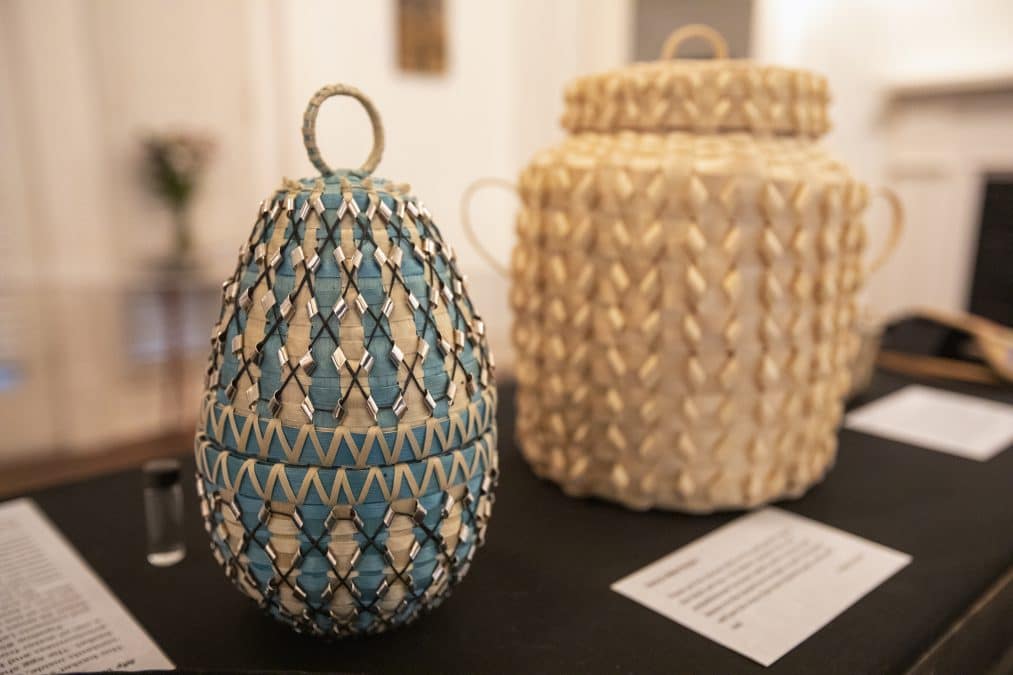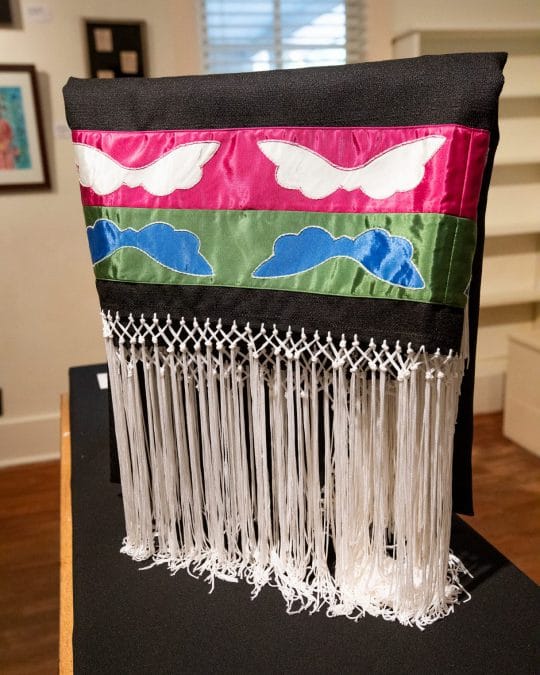Located on the University of Oklahoma campus in Norman, the Jacobson House Native Art Center stands as a testament to the creativity and beauty of Indigenous art throughout the last century. The latest exhibit, Azhwakwa: Contemporary Anishinaabe Art, features five Citizen Potawatomi Nation artists. Odawa, Ojibwe, Prairie Band Potawatomi, Gun Lake Potawatomi and Chippewas of Rama First Nation artists are also featured at Jacobson House from Aug. 22 through Oct. 18.

A desire to reinvigorate the passion and life surrounding this historic building inspired Cherokee Nation artist and publishing editor of the First American Art Magazine, America Meredith, to curate the exhibition.
“There were once important shows going through (Jacobson House), and then it’s kind of fallen by the wayside,” she said. “I thought we needed to have a show that just really knocks people’s socks off, just superb, gorgeous artwork, and a strong cultural tour de force.”
Unique for showcasing only Woodland artists, Azhwakwa comprises basketry, paintings, birch bark biting, porcupine quillwork, installation art, textiles, photographs, jewelry, beadwork and more. Meredith said it is about maintaining cultural connections.
“The fact that people are making those efforts to talk to speakers in the language, meet with people,” she said. “And then some artists, they have to travel back to their historic Great Lakes homelands. They’ve moved away, so they have to travel back to harvest the birch and the black ash and sweetgrass.”
Beyond the woods
Azhwakwa — “Beyond the woods” in Potawatomi — aims to show the resilience of the Eastern Woodland peoples after forced removals and assimilation. Featured artist and CPN member Christopher Short collaborates on appliqué textiles with his mother, Cathy, using a combination of laser cutting and hand sewing.
“Through the art that we’re trying to do, the art that we’ve been working on, I think that we’re helping to acknowledge that culture and that identity that we have and bring it forward and present it. So it remains, maybe not in its original form, but it adapts and helps nourish us and helps inspire us,” Christopher said.
They began working together 15 years ago, although Cathy started sewing dolls clothes as a child. She taught Chris about their family’s culture as Bourassa descendants through art when he was young.
“It shaped who I am; it shaped who they are. And an appreciation for it, a knowledge about it, just seemed to be very critical. And art, especially when you’re starting with small children, seems to be kind of a natural,” Cathy said.

They said textiles lend themselves well to collaboration, and their featured piece at Jacobson House’s new exhibit is a butterfly-patterned shawl with hand-tied white fringe.
“It’s kind of fun to work with bits of cloth and bits of leather and things that you can actually touch,” said Chris, who works in information technology. “I spend a lot of time rendering things on the computer for other art pieces and using Photoshop and (computer-aided design) and 3D programs, and it’s so gratifying to actually hold something in your hand that existed solely on the computer a few hours ago or a few days ago.”
Harnessing new technologies to create pieces rich in Anishinaabe cultural techniques and symbols highlights Meredith’s idea behind the exhibit.
“I hope continuity is the main theme where Native people are going to use their own Indigenous art forms and those will continue on to the future,” she said. “The whole idea that Native is ancient or Indigenous art forms are fading or disappearing is an untrue narrative put forth by Western academics that I think we pretty soundly rejected in the 21st century.”
Coronavirus adaptations
The Jacobson House is a small art space; however, Meredith chooses to see it as an advantage during a pandemic. Staff closely monitor how many visitors enter the exhibit while providing an intimate experience for families and children being homeschooled.
“Some of the artists only have one piece, so that’s how we’re able to accommodate 12 different artists in a really small space,” Meredith said. “But I think they all play off each other very well, and I think we have excellent range of different forms and approaches.”
The Jacobson House requires guests to wear face masks while walking through the exhibit. Visitors can email jacobsonhouse@gmail.com to schedule a private tour. Jacobson House is also offering a series of virtual artist talks every other Monday throughout the exhibit, giving those unable or unwilling to travel a chance to participate and enjoy the art.
“I hope that people see the survival and the resilience of Native people and know these people went through this and they still have beauty in their lives. They’re still creating beauty. We’re going to be able to get through the time we are in now,” Meredith said.
The gallery will be open Saturdays and Sundays from 1 to 5 p.m. through Oct. 18 as well as by appointment. Visit jacobsonhouse.art/exhibitions or facebook.com/jacobsonhouseart for more information.
